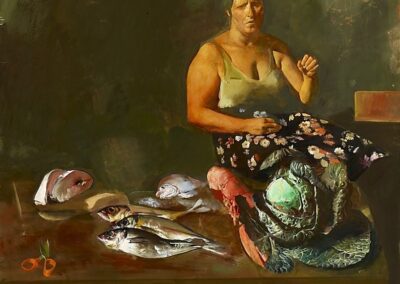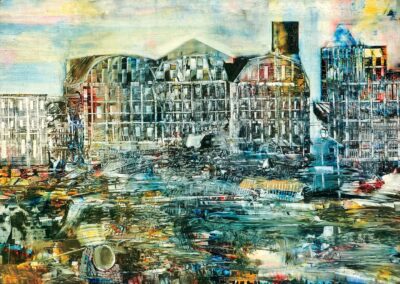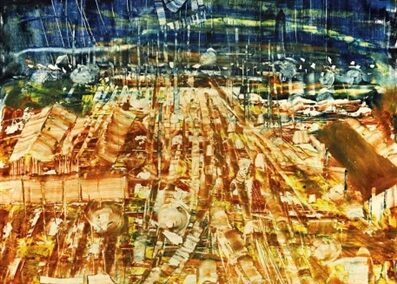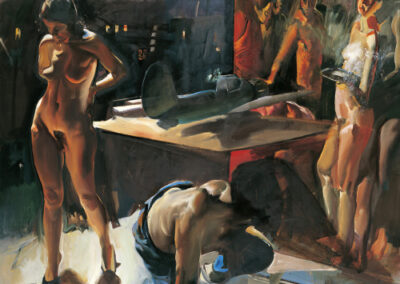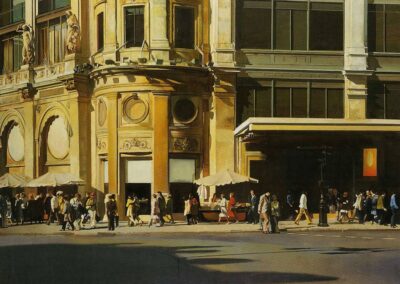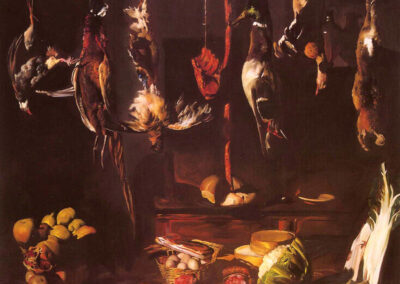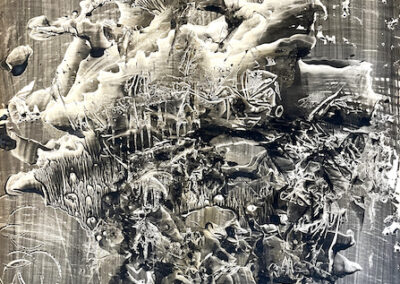Our next Artist You Need To Know is Tibor Csernus (1927 – 2007). He was a Kossuth Prize – winning Hungarian graphic designer and painter.
Csernus was one of the most significant painters when considering 20th Century Hungarian artists. Born in the town of Kondoros in South Eastern Hungary in 1927, Csernus was first educated at a trade school but his desire to draw and paint eventually led him to taking classes from the graphic arts department in 1943. He was also at this time, in conjunction with his studies, a lithographer’s apprentice : at the Posner Printing house he worked under András Benkő who was an influential teacher for him. The next year he was enrolled fully at the School of Applied Arts.
Tibor Csernus’ education was interrupted when he became a prisoner of war in 1945, near the end of World War II.
Csernus resumed his studies in graphic arts after the War (an important teacher Lóránt Sárkány) but he would change his studies to focus upon painting, at the Hungarian Academy of Fine Arts (1946 – 1952), where his teacher was Bernáth Aurél. In 1952, Csernus earned the Mihály Munkácsy Award for his paintings that were on view in the Hungarian Fine Arts Exhibition that year. His work – like many Eastern European artists in post WW II Soviet states – was strongly informed by socialist realism and the figure, but he also drew upon Biblical and more classical themes, as well.
Csernus, from the 1950s onwards, would continue to work in both painting and printmaking, expanding from lithography to monotypes. In 1957 he travelled to Paris which would radically change his practice and ideas, and studied informally the various movements that were happening at that time, as well as focusing on art and artists who had been working in that city between the two wars. André Derain’s work and writing were strong influences on Csernus during this visit and afterwards when he returned to Hungary.
During this period, Csernus would also be painting and working at the Summer artist colony in Szigliget (a village on the northern bank of Lake Balaton in South Western Hungary).
Upon Csernas’ return from Paris, he and several other artists in Hungary formed a loose group that were christened Szürnaturalism [Supernaturalism] by a number of Hungarian critics, but most notably artist and writer Géza Perneczky. These were “younger artists grouped around Tibor Csernus, Gyorgy Korga, László Lakner, Ákos Szabó, and László Gyémánt….Szürnaturalism is constructed from naturalistically painted details, destroyed or distorted to varying degrees, creating surreal paintings in their overall effect. In their works, photo-realistic details alternated with surreal, amorphous parts. Csernus’s “scratch” pictures painted in the early 60s can be considered as examples of the trend…Szürnaturalism flourished in the second half of the 1960s…They did not organize a joint exhibition, the relationship between them was stronger in theory than in practice.” (From the November Gallery)
He relocated to Paris in 1964 and would live and work in that city for the rest of his life (the previous year he had again been recognized with the Mihály Munkácsy Award which was the highest honour given by the Hungarian government for excellence in the visual arts). in the 1970s, Csernus began to create more hyper realistic works. The works for which he’s best known were produced primarily in the 1980s. These are his paintings that have multiple figures, pseudo – academic nude compositions, biblical scenes and still life compositions that owe a debt to the style of the Italian Baroque painter Caravaggio (1571 – 1610). His often monumental expressive – realist paintings from this period, and into the 1990s, also drew inspiration from the English painter William Hogarth‘s (1697 – 1764) series of engravings and the Italian Roccoco artist Gaspare Traversi (1722 – 1770). A critic would later comment that “Csernus’ works are based on painting traditions, but the main characteristic of his work is that it is modern and quite authentic.”
Along with his formal artworks and paintings, Csernus also illustrated a number of books during this time. Two notable ones are Endre Fejes’ novel Rozsdatemető (1962, published in English as Generation of Rust) and Zsigmond Remenyik’s Dust and Ashes.
Important exhibitions of Csernus’ artwork were mounted at Galérie Lambert (Paris, 1964), Galérie du Fleuve (Paris, 1967), Galérie Claude Bernard (Paris, 1973, 1978, 1982, 1986), Ferenc Móra Museum, (Szeged, Hungary, 1983), Chicago International Art Exposition (1984), Műcsarnok Art Gallery (Budapest, 1989 and1999), Kogart House (Budapest, 2006) and a posthumous memorial exhibition at Békéscsaba in his hometown of Kondoros (2007). As previously mentioned, Csernus was also recognized with the Kossuth Prize by the Hungarian government in 1997 to acknowledge outstanding achievements in the fields of science, culture and the arts.
From the gallery text for the 2007 exhibition at Békéscsaba : Csernus’ “painting is never separated from visible reality [which] serves as raw material for him, but when transposed for different purposes, he creates very different, new realities.” In the same text, art historian and curator Gerd Lindner states that: “[Csernus] truly embodies a new, vital realism…in the process of multiple changes.”
Tibor Csernus passed away in Paris in 2007 and is buried in Montmarte cemetery in that city. He had been recognized as a Chevalier d’Arts et Lettres from the French government in 1986 as well as being awarded the Premio Lissone from the Italian government in 1967.
More of Tibor Csernus’s artworks can be seen here and a more complete listing of his exhibitions can be found here.










